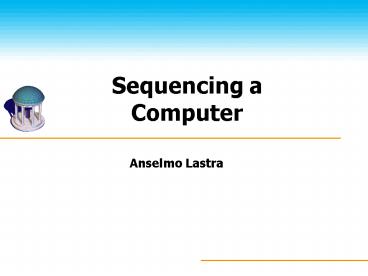Sequencing a Computer - PowerPoint PPT Presentation
1 / 42
Title:
Sequencing a Computer
Description:
No lab next week (holiday on 4/9) No class following week (4/13, 15) I'll be traveling ... Derived from definition of ISA. Hard to design logic manually ... – PowerPoint PPT presentation
Number of Views:45
Avg rating:3.0/5.0
Title: Sequencing a Computer
1
Sequencing a Computer
- Anselmo Lastra
2
Topics for Rest of Semester
- Chapter 10
- An example computer architecture
- Hardwired single-cycle control
- Microprogrammed multi-cycle control
- Chapter 11
- Pipelining and hazards
- RISC and CISC (maybe skip) examples
- Programmable devices (simpler than FPGA)
- Maybe more on I/O and interrupts
3
Schedule
- Two classes next week
- No lab next week (holiday on 4/9)
- No class following week (4/13, 15)
- Ill be traveling
- Class on 4/20
- Maybe lab help session will decide next wk
- Last class on 4/22 wrap-up
- No final (unless objections)
4
Lab Status
- Tomorrow beq
- Last MIPS instruction
- Next add peripherals
5
Chapter 10-7
- Simple computer architecture
- Not unlike MIPS, except 16 bits
- Single-cycle hardwired control
- Multicycle microprogrammed control
6
Instruction Formats
- Register-type instructions
- Only 8 registers (3 bits)
7
Immediate
- Only 3 bits for the immediate value (Op)
- Mostly useful for typical increments/decrement
- Or just as an example
8
Branching
- PC relative branching
- The 6 bits are sign extended to 16
- Opcode might specify branch on zero, if register
SA is zero
9
Example Instructions
10
Contrast to Microoperations
- Although appear similar, theyre not
- Computer instructions fetched using PC
- Branching much more general
- Decoding of computer instructions usually more
complex
11
Resources
- Book implies Harvard architecture
- Separate I and D
- They treat I memory as ROM
- Asynchronous
12
Single-Cycle Control
- Datapath is same as example earlier in Chapter 10
- Looked at in datapath lectures before break
- Next slide shows for review
- First look at overall control
- Then look at instruction decoder
13
Datapath Control Word
14
Block Diagram
15
Architecture
16
Instruction Decoder
- Many lines (the three regs) need no logic
- RISC Style
- Architecture tailored so parts of inst.
correspond to control lines
17
Control
- Not much more to say
- Simple, partly because decoding so
straightforward - Drawbacks
- Some instructions, like multi-cycle shifts, cant
be implemented w/o complex datapath - Two memories (essentially a ROM and an async data
memory) - Two cycles needed to use one memory
- Biggest problem is delay
18
Delay in Single-Cycle Control
- Worst case delay with reasonable components
- Total 17ns
- Could only clock at about 50 MHz
- Pipelining the solution
- First lets look at multi-cycle control
19
Multi-Cycle Hardwired Control
- Goals
- Support more complex instructions
- Use single memory
- Not necessarily coupled with multi-cycle
20
Architecture
21
Instruction Register
- IL load signal for IR
- PS, for PC control
- Hold value multiple cycles, increment, load, etc.
22
Single Memory
- PC addresses memory
- Mux M gates address
- MM signal to select program/data address
- Inst. stored in IR
23
Added Temporary Regs
- Now 16x16
- 8 not visible to user
- New signals to address the registers
24
Sequence Control
25
Control Word
26
Control Design
- Not hard to specify state diagram
- Derived from definition of ISA
- Hard to design logic manually
- If didnt have logic synthesis, would probably
use microprogramming
27
Two-Cycle Instructions
- Simplest instructions have 2 cycles
- Fetch (instruction)
- Execute
- This is minimum necessary
- They assume async memory
- Dont need extra clock cycles
28
Basic Inst.
29
Branch
- Test and modify PC
30
Next Step
- Make a table or write Verilog from ASM diagram
and instruction descriptions - Tedious, but not hard
- Same as youve done, with more details
- State machine easy for these instructions
31
Table from ISA and ASM
32
Load Register Indirect
- Three cycles
- Temporary register used
33
Shift
- Shift right/left multiple
- RSA to be shifted
- First tested for 0
- R9 loaded with shift length
34
Multi-Cycle Table
35
Summary multi-cycle
- Multi-cycle computer enables more complex
instructions - May also be faster
- Later well look at pipelined computers more
parallelism but more complex control
36
Limits to Clock Period
- Conventional datapath
- 12 ns delay, so maximum is 83 MHz clock
- Maybe have even tighter constraints due to
control logic
37
Pipelining
- Break datapath into stages
- Add registers between stages
- Like production line book uses car wash example
- Wash, rinse, dry
38
Latency vs Throughput
- Latency, the amount of time it takes to execute
an instruction, does not change - Inn fact, typically increases
- Throughput, the number of instructions executed
per second, increases - By almost the number of pipeline stages
39
Expected Performance
- Longest stage is 5ns
- So clock can be 200 MHz
- Not 3 x 83 MHz. Why?
- Latency is 15ns
- Also extra hardware
40
Datapath
- 3 Stages
- Operand Fetch
- Execute
- Write Back
- Note that WB register is the register file (same
as at top)
41
Pipelined Execution
- Note pipeline fill and empty
- Efficiency is not 100
- Important to not stall pipeline
42
Next Time
- Pipelined control
- Hazards































